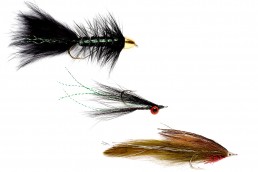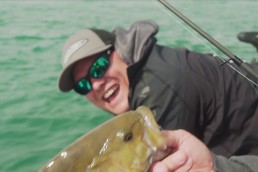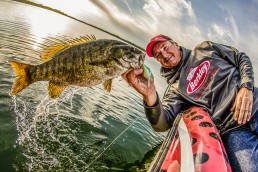Three Classic Streamers Every Bass Angler Needs
SHARE THIS POST
Fly-fishing for bass can be a relaxing time, a serious endeavor or something in between. How casual or serious a fly angler chooses to take it is up to the individual. What makes bass so entertaining is they are everywhere and easy to access. Bass live in every type of water body you can find. They inhabit small farm pounds, natural lakes, rivers, streams and large impoundments. They will take a lot of different style flies and are often very aggressive and are an especially good target species for beginning anglers.
Streamer fly are effective at catching all species of black bass. They are subsurface flies, so you can get down to the bass’s level and they can be retrieved in a variety of ways. While there is a huge selection of streamers, three have withstood the test of time and are a must have for both beginners and longtime anglers.
Woolly Bugger
The Woolly Bugger is one of the most versatile flies on the market. It is simple to tie, can be fished in a variety of ways and most importantly, it catches fish.
It was originally tied by Pennsylvania fly-tier Russell Blessing to resemble a hellgrammite, the nymph form of a Dobson fly, that is plentiful on most freshwater streams. Its versatility on any body of water and the ease with which it catches fish make it a very popular fly.
A standard Woolly Bugger consists of a chenille body, marabou tail, wire ribbing and a saddle hackle. One of the best things about the Bugger, is that it can be tied in a variety of ways. To get the fly deeper, you can wrap lead on the hook shank, use a beadhead or barbell eyes. This will not only get the fly deeper in the water column, but will also add more action.
Materials
Hook: Dai-Riki #700 Size 10
Bead: Cyclops Wapsi 5/32 Gold Bead
Thread: UTC Brown Olive 140
Body: Lead wire .02 wt / Chenille (olive)
Hackle: Whiting Bugger pack
Tail: Marabou olive blood quill
Instructions
Step 1: Wrap lead wire on hooks shank leaving some space below the eye and above the hook bend.
Step 2: Start thread on hook near eye of the thread and lay a base of thread down.
Step 3: Take a clump of marabou that is roughly the length of the flat part of the hook shank, place it on the hook shank just before the bend and secure with the thread. Leave bobbin with thread in the back.
Step 4: Tie in an edge of the chenille just back of the eye of the hook and wind the chenille with forward wraps along the hook shank to just before the eye. Wrap chenille backwards until it meets the marabou tail and tie it off with the thread. Cut off and discard the leftover chenille.
Step 5: Tie in the hackle in by the small tip. Wind forward with even wraps to just below the eye. Carefully wind the thread through the hackle, taking care not to pinch down any part of the hackle tips. Clip off the excess hackle and add a few wraps of thread, then secure with a whip finish knot and add a couple of drips of head cement to the knot.
Clouser Minnow
The Clouser Minnow could possibly be the most-productive streamer fly ever designed. The legendary Bob Clouser, a Pennsylvania fly-tier and guide, designed the fly to catch smallmouth on the Susquehanna River. Clouser was looking for a type of streamer he could design that would react much like a Rapala acted when it was twitched or jerked.
Clouser started his quest for the perfect smallmouth streamer in the 1980s, but it wasn’t until he received a package of barbell eyes from the Wapsi Fly Company that he had perfected what he had set out to do.
“The barbell eyes completed the aesthetics of the fly,” Clouser told me in a 2012 interview. “It provides the action that triggers fish to bite. When you retrieve the fly, it rises. When you pause, the fly darts off to the side or drops down. It never stops moving.”
The Clouser Minnow is so effective that Lefty Kreh claimed to have taken 86 different species on this fly.
Materials
Hook: TMC 9395 #2-12
Thread: 3/0 Monocord
Eyes: Painted Lead or Brass Eyes, sized to hook
Belly: White Bucktail
Flash: Krystal Flash
Back: Chartreuse Bucktail
Instructions
Step 1: After lying a thread base on the hook shank, tie in the barbell eyes toward the front of the hook shank, leaving a space between the eye of the hook.
Are you enjoying this post?
You can be among the first to get the latest info on where to go, what to use and how to use it!
Step 2: Tie in the white Bucktail behind the barbell eye’s using just enough thread wraps to secure it, while leaving Bucktail in front the eyes. Go forward of the barbell eyes and, using several thread wraps, tie the bucktail flat with the surface of the hook shank. Neatly trim Bucktail away from the eye of the hook.
Step 3: Turn fly upside down in the vise. Take two pieces of Krystal flash and double them around the tread. Wrap thread to tie in the Krystal Flash.
Step 4: Tie in the chartreuse bucktail on the bottom side of the hook shank, only wrapping forward of the barbell eyes.
Step 5: Finish the fly with a whip finish knot and place a couple of drops of head cement on the nose of the fly.
Lefty’s Deceiver
Just how famous was the late Lefty Kreh and his prominent streamer the Lefty’s Deceiver? It was famous enough that it was chosen by the U. S. Postal Service to be placed on a stamp in 1991. The fly, like most famous patterns, was tied to simply solve a problem.
Kreh and a friend frequented the Chesapeake Bay to chase the legendary striper runs of the 1950s with a fly rod. The problem was that most of the streamer flies of that era had feather wings that frequently tangled or under-wrapped the hook, spoiling the retrieve. It was so frustrating to cast to breaking fish only to find that the fly had fouled.
“I told my friend Tom Cofield I’m going to design a fly that won’t foul on the cast,” Kreh recalled. “It will have a fish shape, but can be made in many lengths. You can vary the color combinations. It will also swim well but when lifted for the back cast it will be sleek and have little air-resistance.”
That simple problem solving led to Lefty’s Deceiver, a legendary and productive fly. Kreh was not trying to accomplish anything other than to tie a better fly, but word spread and the Deceiver has become one of the most productive streamers in history.
“I wasn’t trying to redesign the wheel,” Kreh Explained. “Just like most anyone who was tying something new. I only hoped it would work and didn’t consider it might become a part of fly-fishing history.”
Materials
Hook: Mustad 34007, sizes 2/0-6
Thread: Fluorescent yellow, 140 denier
Tail: White saddle hackles, 3X length of hook shank
Flash: Pearlescent Krystal Flash and medium Flashabou
Body: Silver or pearl braid
Wing: White bucktail
Overwing: Chartreuse bucktail
Gills: Red Krystal Flash
Head: Tying thread
Instructions:
Step 1: Tie three or four pairs of white rooster saddle feathers, these must be V-shaped and tied with the tips pointing out.
Step 2: Tie some Flashabou strips or pearled Crystal Flash at each side of the fly, at the base of the tail feathers.
Step 3: Wrap thread forward. To make the wing, tie in white bucktail at the tip of the hook.
Step 4: Tie in another section of bucktail on the bottom of the hook shank to shape the body.
Step 5: Tie over the wing a chartreuse strap of bucktail hair.
Step 6: Tie over the wing a chartreuse strap of bucktail hair.
Step 7: For the throat, tie a bit of red flashabou. Even out the head with thread to add volume to the fly.
Step 8: Give a few more thread wraps to make sure the head has volume and is even. Use a whip finish knot and add head cement.
MWO
SHARE THIS POST
Did you enjoy this post?
You can be among the first to get the latest info on where to go, what to use and how to use it!



